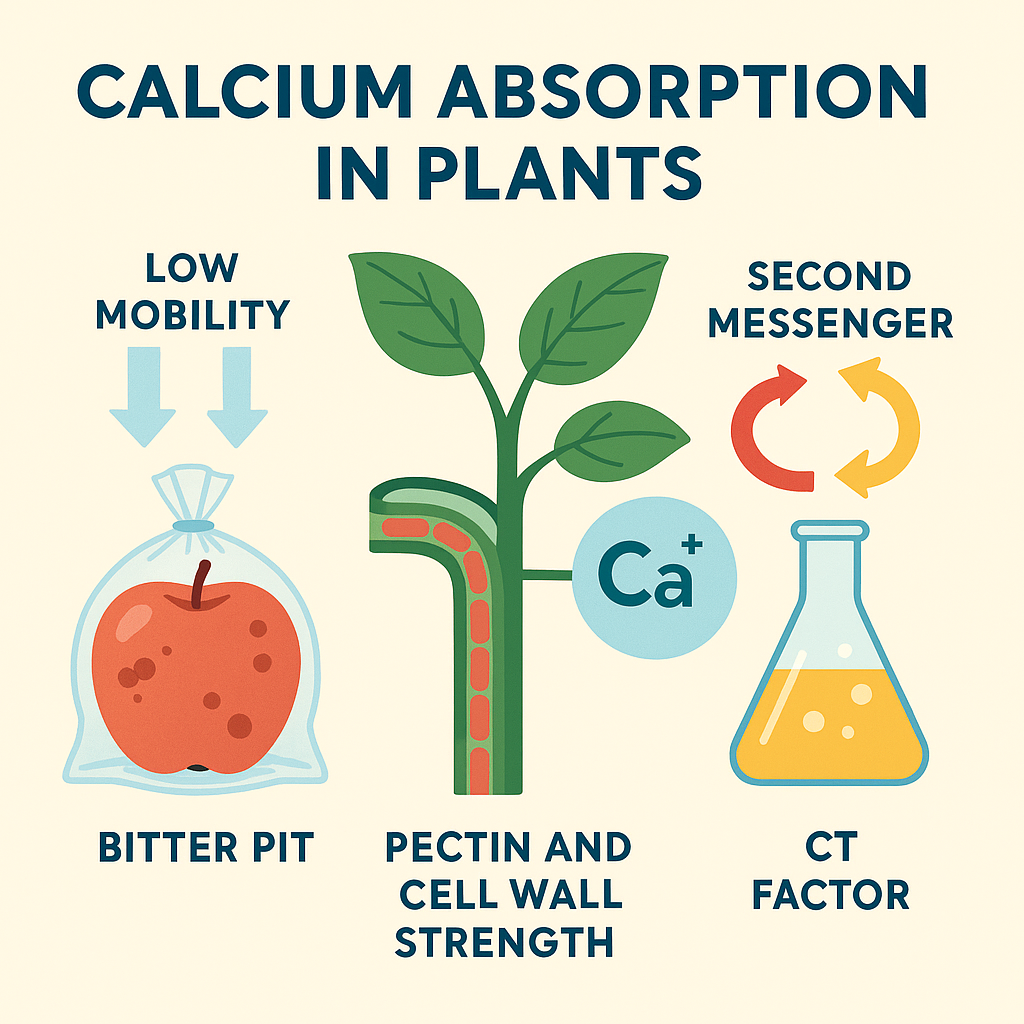Calcium plays an essential role in plant development. Yet despite its abundance in soil, plants often suffer from calcium deficiency. Why is calcium so difficult to absorb, and how can growers solve this problem effectively? In this article, we explore the root causes, symptoms, key application timing, product comparisons, and breakthrough technologies to improve calcium uptake in plants.
1. The Chemical Nature of Calcium: The Root of Poor Mobility
Calcium (Ca²⁺) is a typical alkaline earth metal with relatively low mobility in plant tissues. Inside the plant, it usually binds in stable forms or precipitates, especially as calcium pectate in cell walls, providing structural support. However, this also limits calcium’s ability to relocate to growing tissues.
Calcium also tends to bind with oxalic acid, forming calcium oxalate crystals, making it even less mobile. In fruit production, especially in bagged fruit (e.g., bagged apples), the situation worsens. Bagging reduces transpiration, a key driving force behind calcium uptake, leading to severe deficiencies and disorders such as bitter pit.
2. Calcium Deficiency: The Hidden Killer Behind Nutritional Imbalances
Calcium is vital for:
- Cell wall strength: Calcium pectate acts as a “steel bar” in plant cell walls.
- Membrane stability: Prevents leakage of cellular contents and reduces fruit cracking.
- Stress signaling: Acts as a second messenger in drought, heat, and pest resistance pathways.
Typical symptoms of calcium deficiency include:
- Apical meristem necrosis: e.g., yellowing and death of cucumber tips.
- Physiological disorders in fruits: such as bitter pit in apples or blossom-end rot in tomatoes.
- Softening of tissues: like soft berries in grapes or water-soaked spots in mango.
Studies show that calcium deficiency can cause up to 70% bitter pit incidence in apples, drastically reducing commercial fruit quality and market value.
3. Timing Is Everything: When to Apply Calcium for Maximum Absorption
Calcium uptake in plants is not constant; it follows specific growth stages:
- Fruit set and early development (cell division stage): Demand begins to rise, accounting for 20–30% of total calcium needed. Supplementation at this stage supports cell wall formation.
- Fruit enlargement (cell expansion stage): Calcium demand peaks, often exceeding 50% of total requirements. Adequate calcium at this stage improves fruit size, firmness, and storage quality.
- Pre-harvest (maturity stage): Supplemental calcium helps reduce post-harvest diseases and extend shelf life.
By aligning calcium applications with these stages, growers can significantly improve absorption efficiency and crop quality.
4. Comparing Calcium Products: Know the Differences, Avoid the Pitfalls
Choosing the right calcium fertilizer is crucial. Here is a comparison of common calcium products:
| Product Type | Main Ingredient | Absorption | Advantages | Limitations |
|---|---|---|---|---|
| Calcium Nitrate | Ca(NO₃)₂ | ★★★ | Fast-acting, water-soluble | Easily leached, less effective via foliar |
| Calcium Acetate | Ca(CH₃COO)₂ | ★★★ | Good foliar uptake | Low stability, sensitive to rain |
| Chelated Calcium | EDTA-Ca, DTPA-Ca | ★★★★ | Highly stable, not easily precipitated | Expensive, pH-dependent |
| Sugar Alcohol Calcium | Ca + polyols | ★★★★ | Promotes active transport in plants | Higher cost, some instability |
| Seaweed Calcium | Marine-derived calcium | ★★ | Rich in trace nutrients | Low calcium content, slow effect |
Don’t just look at calcium percentage—consider bioavailability, delivery method, and compatibility with crop stage.
5. A Breakthrough Solution: CT Factor Technology for Active Calcium Transport
Solving the Bagged Apple Problem
In 2004, Dr. Dayong Chang from China Agricultural University found that calcium deficiency in bagged apples led to a 70% incidence of bitter pit. Traditional foliar spraying of calcium nitrate only increased calcium content by 3–5%, far from sufficient.
To tackle this global challenge, Dr. Chang’s team developed the CT Factor (Calcium Transfer Factor) based on marine organism fermentation. This technology enables active secondary transport of calcium within plant tissues.
How CT Factor Works: Dual Activation Pathways
CT Factor is a bio-derived cyclic pentapeptide fermented by Bacillus subtilis (CGMCC strain). Its core functions include:
- ✅ Activating CACIU-T calcium pathway: Upregulates calcium channel gene CAX1 by 3.7x (qPCR verified), improving calcium influx.
- ✅ Enhancing pectin synthesis: Activates vitamin K₂–dependent carboxylase, increasing calcium pectate synthesis by 62%.
This dual mechanism significantly enhances calcium mobility and deposition in fruit tissues, overcoming the limitations of conventional fertilizers.
Integrated Calcium Management for Stronger, Healthier Plants
Understanding calcium’s limited mobility, recognizing the signs of deficiency, and applying calcium at the right developmental stages are all essential for crop success. But in today’s agriculture, timing and product choice alone are no longer enough.
Thanks to innovations like CT Factor Technology, growers now have access to a new generation of calcium solutions—ones that actively enhance calcium transport and deposition within the plant.
- Stronger cell walls
- Reduced fruit disorders
- Longer shelf life
- Higher market value
By adopting a science-based, systemic calcium management approach, you don’t just prevent problems—you grow stronger plants, better fruit, and a more profitable future.
👉 Want to learn more about CT-enhanced calcium solutions for your crops? Contact us at sales@wellyoutech.com


